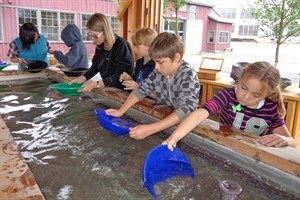
Visitors pan for gold at the Britannia Mine Museum in Britannia Beach, B.C. between Vancouver and Whistler on Friday, May 17, 2013. THE CANADIAN PRESS/Camille Bains
May 21, 2013 - 1:19 PM
BRITANNIA BEACH, B.C. - A big yellow dump truck along the Sea to Sky highway is no match for the mountains-and-ocean view between Vancouver and Whistler, but curious travellers would be in for a treat if they stopped at an adjoining museum that holds the secrets of a bygone era.
The Britannia Mine Museum features the history of the copper mine that was once the largest in the British Empire and employed 60,000 workers between 1904 and 1974, when it was closed.
The museum that made its debut the following year and is a national historic site has been steadily expanding since then.
Besides a kids' play area and a gold-panning station that's a huge hit, the museum includes a guided train tour of a former service tunnel, similar to the 210-kilometre tunnels where workers toiled six days a week.
Guide Isabelle Akerhielm warns visitors in hard hats that the tunnel will go dark for a few seconds "and you won't be able to see your hand in front of your face, guaranteed."
She says miners spent much of their days working by candlelight before switching to carbide lamps and then later head lamps with battery packs on their backs.
"The thing to remember is that there are still people in third-world countries mining by candlelight," she says, before telling visitors to cover their ears.
She unleashes a blast from a replica drill called the widow maker, so named because some miners developed the lung disease silicosis from inhaling the silica dust in the mine.
Akerhielm then displays the so-called honey wagon, which looks like an old ice-cream cart on wheels. It's actually a travelling toilet that features a seat on either side when the rectangular lids are lifted.
A new worker's first job inside the tunnel was to roll the wagon around the tunnel twice during his shift.
"The new guy was responsible for it for 30 days and he got to know the layout of the tunnel before becoming a miner. He got to know his co-workers very, very well. They were happy to see him."
The tour continues to a massive white structure called Mill 3, which was constructed between 1921 and 1923 to process ore.
The building was renovated after the mine closed and is the equivalent of a 20-storey skyscraper built into the side of a cliff.
Inside, there's a staircase of 241 steps that miners climbed daily to get to their stations — but without the current railings, Akerhielm says.
"I can tell you from personal experience that the climb up is exhausting and the climb down is terrifying."
Besides copper, gold, silver, lead, zinc and cadmium were also extracted at the mill.
Since its starring role in the mining business, the building has been used in the "X-Files" TV show, along with films including "Scooby Doo 2: Monsters Unleashed," in which it appears as a monster factory.
In another building, artifacts from mining's heyday tell the stories of families from the nearby communities of Mount Sheer and Britannia Beach, which could access Vancouver only by steamship before the highway was built in 1958.
Along with photos from the annual Copper Queen social, there's a love letter from a miner to his sweetheart in England in 1961.
He writes he may be in Vancouver during an upcoming break at the same time legendary singer Bing Crosby was to visit the big city.
Kirsten Clausen, the museum's executive director, says workers from 50 countries lived in the towns that slowly faded away when the struggling mine was shut down in 1974.
She says the closure was partly due to the anti-mining environmental views of the 1970s.
An acidic soup from a natural process at the mine had been draining into creeks and polluting Howe Sound, but funding from government and industry later allowed the water to be diverted and treated.
"Mining is not the way it was 30 years ago or 100 years ago," Clausen says, noting similar environmental concerns are now being discussed about other industries involving pipelines and fracking.
"If you want to give up mining, then you don't buy an iPhone every year, you don't travel in cars, and we're going to have to be selective about our choices," she says about the metals mining provides for everyday objects.
About 500 people currently live in the village of Britannia Beach, which has been slated for development by a Chinese company aiming to build up to three hotels, a winery and about 4,000 homes in the area.
———
If You Go...
Britannia Beach is about 45 minutes north of downtown Vancouver. Drive over the Lions Gate bridge toward West Vancouver. Turn right onto Taylor Way and take the Upper Levels Highway. Follow the signs to Squamish/Whistler on Highway 99 (Sea to Sky highway) and turn right onto Copper Drive at Britannia Beach.
News from © The Canadian Press, 2013